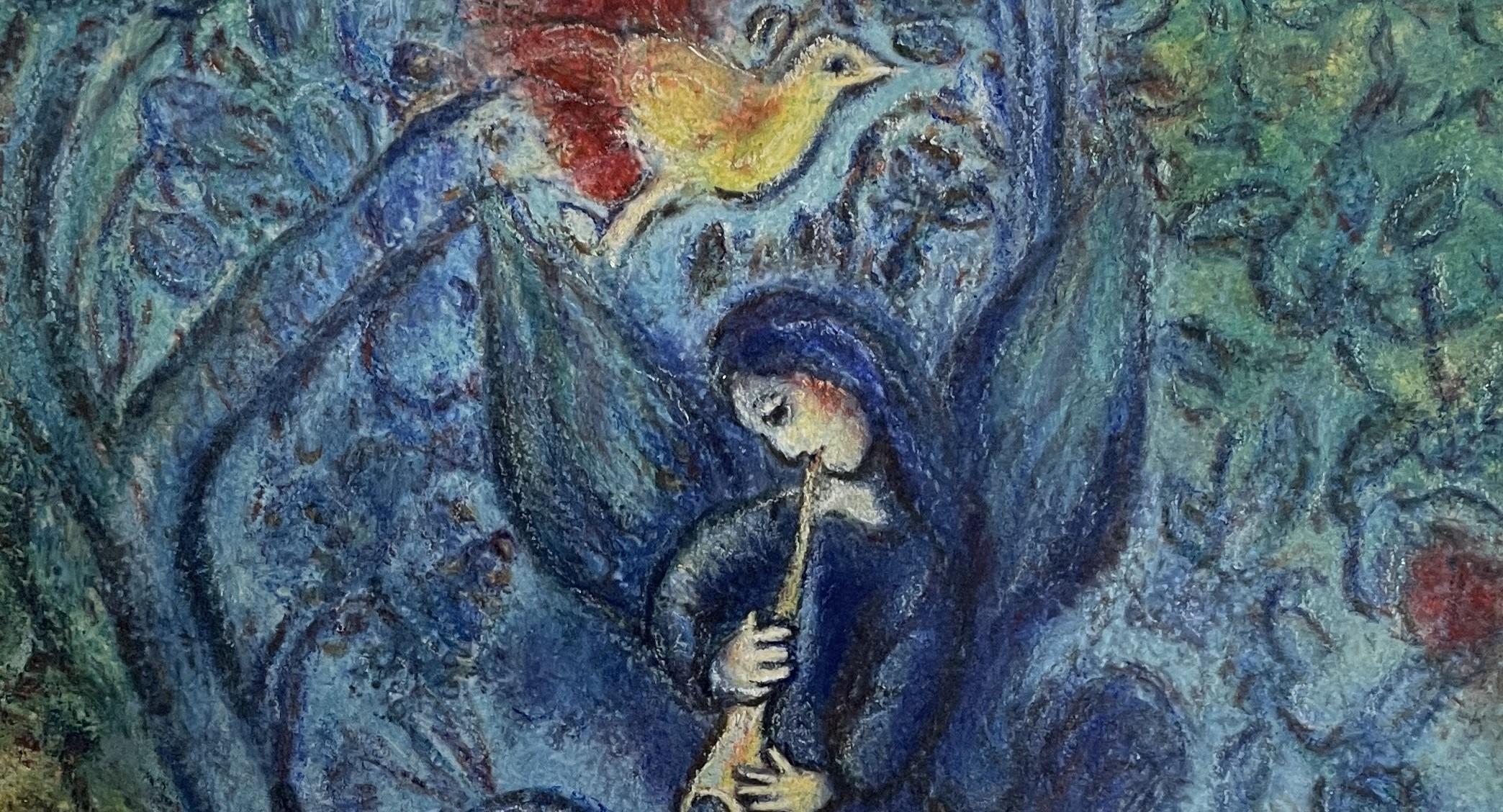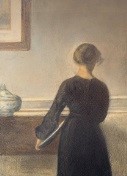日本語-Englishー台灣華語
ハマスホイ「背を向けた若い女のいる室内」
スペインの仕事帰りに立ち寄ったせいなのか、はじめて訪れたコペンハーゲンの街に差し込む光は、斜めから柔らかく降り注ぎ、街全体が青白い印象を受けた。私はその時ハマスホイの絵にも描かれているロイヤルコペンハーゲンの青い絵付けの白い陶器を買ったのを昨日のことのように思い出す。あれから30年近くたって、私ははじめてハマスホイの絵を東京の大回顧展で目にした。
ハマスホイは、19世紀末から今世紀はじめに活躍したデンマークの画家である。裕福な商家の次男として生まれ、幼い頃よりアカデミックな英才教育を受けている。生前から欧州各国で個展が開かれ、好評を博していたが、死後忘れ去られてしまう。かつてロシアバレエ団のディアギレフや詩人のリルケが称賛していただけのことはあるが、はじめて観る私には、ハマスホイが描く建物や肖像画は総じてつまらなく見えた。唯一、白い室内に後ろ向きに妻イーダを描いた人物画だけが強く輝いて見えるのだった。私は展覧会のポスターにもなっていた「背を向けた若い女性のいる室内」を描くことにした。
私ははじめ、この絵は何気ない一瞬をとらえた写真のような絵であると思っていたが、描きはじめてみると、随分と構成された絵であることに気付く。後ろにかけられた額の絵は、唐突にトリミングされた写真のようにその一部が見えるだけなのだが、よく見ると壁の縁飾りも額と同じように断ち切られ、二重に反復されている。陶器の蓋の位置は、壁の縁飾りと同じ位置に並んでいる。家具の上に置かれた陶器は、アップにした女性の髪形と呼応している。随分と大きな陶器である。女性の頭部より大きく描かれているのには何か理由があるのだろうか。後ろ向きの女性は一見表情がないような印象を受けるが、体を捻った状態にあり、顔の向きが捻った方向と反対を向きS字になっている。右手がお盆の上部に少し見え、捻りがより強調されている。女性の黒い服は皺が丁寧に描き込まれ、この絵に静かな中にも生気を与えている。ハマスホイの絵画に漂う静謐さは、やはりその独特の色彩に由来する。「絵というものは色が少なければ少ないほど、最高の色彩効果を発揮する」と画家自身が語っているように、淡い青灰色と白の画面の中に、美妙なニュアンスの色を表現している。展覧会ではハマスホイが実際に使っていたパレットが展示されていたが、青と白と灰色が大半を占めるパレットの真ん中に、黄色が少し置かれていた。ハマスホイの色味はクノップフの絵画に似ているところがあるが、貴族的香りというのではなく、病に陥りそうでいてかろうじて踏みとどまっている危うい色彩である。病に至る一歩手前の人がみせる不安感なのだろうか。ふと私は死に至る姉を描いたムンクの絵に漂うものと同じものを感じてしまう。
ハマスホイは、新しい美術潮流のまっただ中のパリにあっても「私は新しい芸術よりは、古い芸術からより多くを学んでいます」と母に書き送っている。ハマスホイがフェルメールやピーテル・デ・ホーホといった17世紀オランダ絵画のイメージを継承しているとしても、そこには独特の空気感が漂っている。それは何よりもハマスホイ自身の気質に由来するのだろう。ハマスホイは初期の段階から押さえた色調で静謐な室内を描いていた。流行にとらわれることなく、自分の美意識を生涯貫き通した画家の絵は、百年の時を経て、今再び脚光を浴びている。画家は結局自分が本来持っている気質に合った絵を描くのが何よりであることを、ハマスホイの絵は教えてくれる。
Interior, Young Woman Seen from Behind
Perhaps it was because I stopped by after work in Spain, or because it was my first visit to the city of Copenhagen, but the light that penetrated the city was softly pouring in from an angle, giving the entire city a pale blue impression. I remember buying the white porcelain with blue paintings from Royal Copenhagen, depicted in Hammershøi’s paintings, as if it were yesterday. Nearly 30 years later, I saw a Hammershøi painting for the first time at a major retrospective exhibition in Tokyo.
Hammershøi was a Danish painter who flourished from the end of the 19th century to the beginning of this century. Born as the second son of a wealthy merchant family, he received an academic education from a young age. He had solo exhibitions in various European countries during his lifetime and was well-received, but was forgotten after his death. It’s no wonder that the Russian Ballet’s Diaghilev and the poet Rilke praised him, but to me, seeing his work for the first time, Hammershøi’s buildings and portraits seemed altogether uninteresting. The only exception was a portrait of his wife Ida, seen from behind in a white interior, which appeared to shine brightly. I decided to paint ‘Interior with a Young Woman from Behind,’ which had also been used for the exhibition poster.
At first, I thought this painting was like a photograph capturing a casual moment, but as I began to paint, I realized it was quite a composed picture. The picture frame in the background shows only a part, like a abruptly cropped photo, but on closer inspection, the wall’s trim is cut off in the same way, creating a double repetition. The position of the porcelain lid aligns with the trim on the wall. The porcelain placed on the furniture echoes the woman’s hairstyle. It’s a considerably large piece of porcelain. It is depicted larger than the woman’s head, which might have some reason behind it. The woman facing away seems expressionless at first glance, but her body is twisted, with her face turned in the opposite direction of the twist, forming an S-shape. Her right hand is slightly visible on the top of the tray, emphasizing the twist even more. Her black dress is meticulously wrinkled, giving this quiet painting a sense of life. The tranquility emanating from Hammershøi’s paintings indeed comes from his unique use of color. As the painter himself said, ‘The fewer colors in a painting, the greater the color effect,’ expressing exquisite nuances of color within a canvas of pale bluish-gray and white. At the exhibition, Hammershøi’s palette was displayed, with blue, white, and gray dominating the center, with a little yellow placed in the middle. Hammershøi’s color palette resembles that of Knopf’s paintings, not in an aristocratic scent but in a precarious color that seems on the verge of illness yet barely holding back. Perhaps it’s the anxiety of someone one step away from sickness. Suddenly, I felt the same aura in Munch’s painting of his dying sister.
Even in the midst of Paris’s new art trends, Hammershøi wrote to his mother, ‘I learn more from old art than from new art.’ Even if Hammershøi inherited the image of 17th-century Dutch paintings by Vermeer and Pieter de Hooch, there’s a unique atmosphere about them, most likely stemming from Hammershøi’s own temperament. From an early stage, Hammershøi painted tranquil interiors with subdued colors. The paintings of an artist who lived his life adhering to his own aesthetic sense, without following trends, are now receiving renewed attention after a hundred years. Hammershøi’s paintings teach us that ultimately, it is best for a painter to paint pictures that suit their innate temperament.
哈馬斯霍伊「背向著的年輕女子的室內」
可能是因為剛從西班牙下班後順道一訪的關係,第一次踏足哥本哈根時,斜射的光線柔和地灑下,讓整個城市呈現一種蒼白的印象。我記得那時購買了哈馬斯霍伊畫作中出現的皇家哥本哈根藍花瓷白瓷,就如同昨日之事般清晰。近30年過去了,我第一次在東京的大型回顧展覽中見到哈馬斯霍伊的畫作。
哈馬斯霍伊是一位於19世紀末至本世紀初期活躍的丹麥畫家。他出生於一個富裕的商人家庭中的次子,從小接受了學術型的優質教育。生前他在歐洲各國舉辦過多次個展,深受好評,但過世後逐漸被遺忘。曾經得到俄羅斯芭蕾舞團的迪亞基列夫和詩人里爾克等人的讚賞,但對於我這第一次觀看他作品的人來說,哈馬斯霍伊所繪的建築和肖像總體來說似乎平淡無奇。唯一例外的是,那幅畫中以白色室內為背景,背向觀眾的妻子伊達的畫作,卻顯得異常耀眼。我決定畫下那幅也作為展覽海報的「背向著的年輕女子的室內」。
起初,我認為這幅畫不過是捕捉了一個平凡瞬間的照片式畫作,但當我開始畫畫時,我意識到這實際上是一幅布局經過精心構思的作品。畫中背景的畫框,看似突兀地被剪裁,只露出一部分,但仔細觀察會發現,牆壁的裝飾邊緣也被同樣切割,形成重複效果。陶瓷蓋的位置與牆壁的裝飾邊緣排列成一直線。擺在家具上的陶瓷與女性的髮型相呼應,是相當大的一件陶瓷。它被畫得比女性的頭部還大,背後一定有其原因。背向的女性乍看之下似乎沒有表情,但她的身體呈現扭轉狀態,臉部方向與扭轉方向相反,形成S形。右手輕輕放在托盤上部,進一步強調了扭曲感。女性的黑色衣物上細膩地描繪了皺摺,為這幅畫增添了一絲靜謐中的生機。哈馬斯霍伊畫作中的寧靜感,確實源於其獨特的色彩。「畫作中的色彩越少,就能發揮出最佳的色彩效果」,正如畫家自己所言,淺藍灰色和白色的畫面中,展現了微妙的色彩變化。展覽中展出了哈馬斯霍伊實際使用的調色板,以藍色、白色和灰色為主,中間點綴了一些黃色。哈馬斯霍伊的色調與克諾普夫的畫作有相似之處,但不是貴族的香氣,而是一種瀕臨疾病卻勉強維持的脆弱色彩。這是臨近疾病的人所展現的不安感嗎?我突然感受到與蒙克描繪即將死去的姐姐的畫作中流露的相同情感。
即便哈馬斯霍伊身處於新藝術潮流的中心巴黎,他仍向母親寫道:「我從古老的藝術中學到的比新藝術多」。儘管哈馬斯霍伊繼承了維梅爾和皮特·德·霍赫等17世紀荷蘭畫家的影響,但他的作品仍然散發著一種獨特的氛圍,這無疑源於哈馬斯霍伊自身的性情。他從早期就以壓抑的色調描繪寧靜的室內景觀,不隨波逐流,一生堅持自己的美學理念。經過百年的流轉,這位畫家的作品今日再次受到關注,哈馬斯霍伊的畫作告訴我們,畫家最終還是會畫出與自己本性最匹配的作品。


